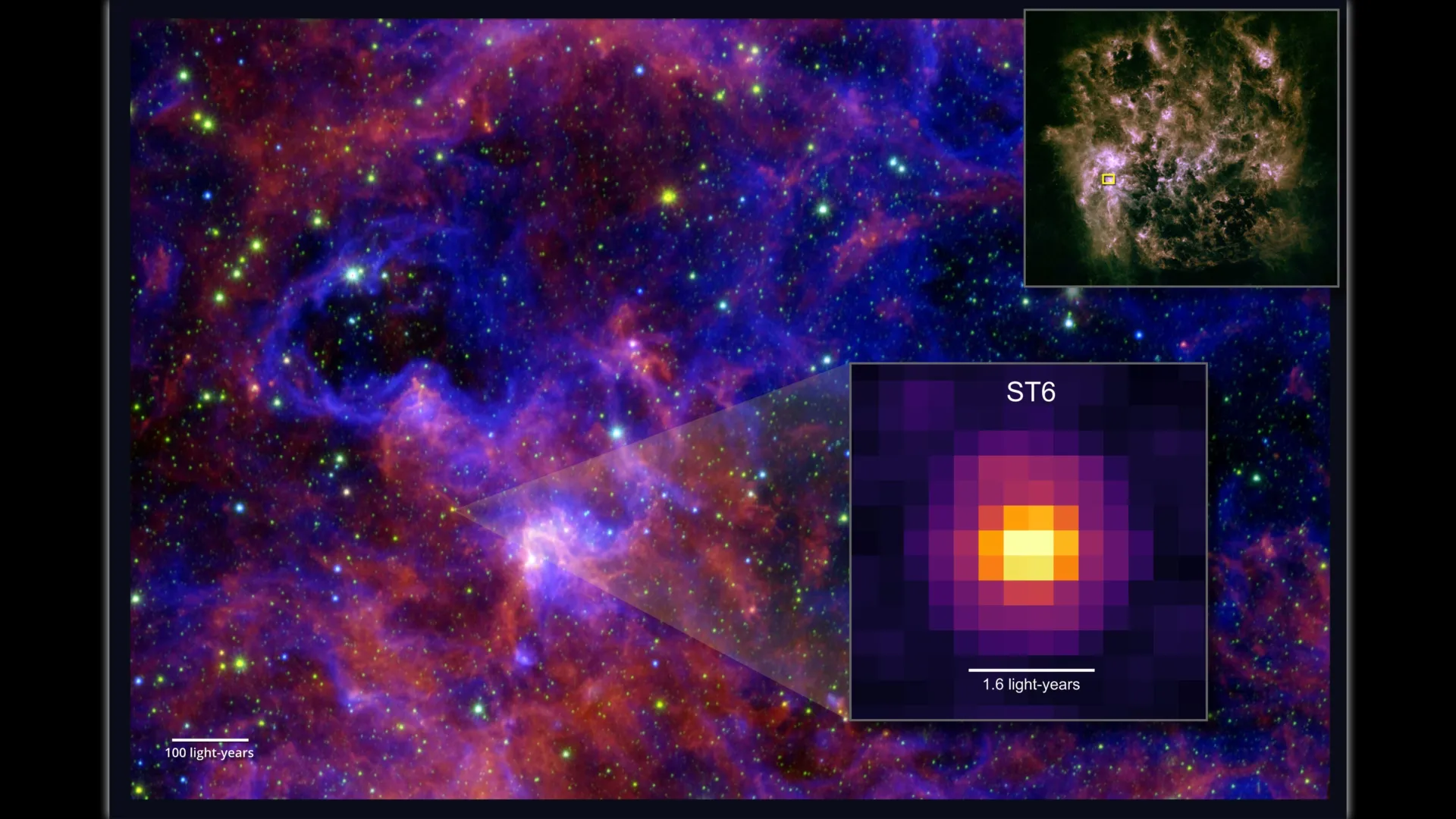NASA's Webb finds life’s building blocks frozen in a galaxy next door
JWST uncovered life’s chemical seeds frozen in alien starlight, proving the cosmos brews organics far beyond our galaxy.
- Date:
- November 12, 2025
- Source:
- University of Maryland
- Summary:
- Astronomers using the James Webb Space Telescope have uncovered a trove of complex organic molecules frozen in ice around a young star in a neighboring galaxy — including the first-ever detection of acetic acid beyond the Milky Way. Found in the Large Magellanic Cloud, these molecules formed under harsh, metal-poor conditions similar to those in the early universe, suggesting that the chemical precursors of life may have existed far earlier and in more diverse environments than previously imagined.
- Share:

In a finding that could change how scientists understand the spread of life's ingredients across space, astronomers have detected large organic molecules frozen in ice around a forming star called ST6 in a galaxy beyond the Milky Way.
Using the James Webb Space Telescope's (JWST) Mid-Infrared Instrument (MIRI), the research team identified five carbon-based compounds in the Large Magellanic Cloud, our closest neighboring galaxy. The study, led by University of Maryland and NASA scientist Marta Sewilo, was published in the Astrophysical Journal Letters on October 20, 2025.
Detecting Life's Chemical Ingredients in Alien Ice
Sewilo's group found five complex organic molecules (COMs) within the ice surrounding the young protostar. These included methanol and ethanol (both types of alcohol), methyl formate and acetaldehyde (industrial chemicals on Earth), and acetic acid (the main ingredient in vinegar). One of the compounds, acetic acid, had never before been definitively observed in space ice, while the others -- ethanol, methyl formate, and acetaldehyde -- were detected in ices outside the Milky Way for the first time.
The team also spotted signs of glycolaldehyde, a sugar-related molecule linked to RNA formation, though further analysis is required to confirm it.
JWST's Sharp Vision Opens a New Window on Cosmic Chemistry
"It's all thanks to JWST's exceptional sensitivity combined with high angular resolution that we're able to detect these faint spectral features associated with ices around such a distant protostar," Sewilo said. "The spectral resolution of JWST is sufficiently high to allow for reliable identifications."
Before the Webb telescope, methanol was the only complex organic molecule ever confirmed in ice around protostars -- even within our own galaxy. According to Sewilo, the extraordinary precision of the new data allowed her team to extract an unprecedented amount of information from a single spectrum.
A Harsh Galaxy as a Laboratory for Life's Origins
The discovery is especially striking because of where the molecules were found. The Large Magellanic Cloud, located about 160,000 light-years from Earth, is an ideal environment for studying how stars form in conditions resembling those of the early universe. This small galaxy has only about one-third to one-half the heavy elements (those with atomic numbers greater than helium) of our solar system and endures far more intense ultraviolet radiation.
"The low metallicity environment, meaning the reduced abundance of elements heavier than hydrogen and helium, is interesting because it's similar to galaxies at earlier cosmological epochs," Sewilo explained. "What we learn in the Large Magellanic Cloud, we can apply to understanding these more distant galaxies from when the universe was much younger. The harsh conditions tell us more about how complex organic chemistry can occur in these primitive environments where much fewer heavy elements like carbon, nitrogen and oxygen are available for chemical reactions."
How Complex Molecules Form on Cosmic Dust
Study co-author Will Rocha of Leiden University in the Netherlands noted that COMs can form in both the gas phase and in icy layers coating interstellar dust grains. Once formed, these ices can later release their molecules back into the gas. Methanol and methyl formate had already been observed in the gas phase within the Large Magellanic Cloud, but this is the first evidence that such molecules are also forming in the solid ice itself.
"Our detection of COMs in ices supports these results," Rocha said. "The detection of icy COMs in the Large Magellanic Cloud provides evidence that these reactions can produce them effectively in a much harsher environment than in the solar neighborhood."
Life's Ingredients May Have Formed Early in the Universe
The presence of these complex molecules in a low-metallicity environment similar to those found in the early universe suggests that the building blocks of life may have begun forming much earlier -- and in a wider range of conditions -- than scientists once thought.
While this discovery does not prove that life exists elsewhere, it indicates that organic compounds can endure through the process of planetary formation and potentially be incorporated into young planets, creating conditions where life might one day emerge.
Expanding the Search for Cosmic Chemistry
Sewilo and her collaborators plan to extend their work by examining more protostars in both the Large and Small Magellanic Clouds to explore how widespread these molecules may be.
"We currently only have one source in the Large Magellanic Cloud and only four sources with detection of these complex organic molecules in ices in the Milky Way. We need larger samples from both to confirm our initial results that indicate differences in COM abundances between these two galaxies," Sewilo said. "But with this discovery, we've made significant advancements in understanding how complex chemistry emerges in the universe and opening new possibilities for research into how life came to be."
Story Source:
Materials provided by University of Maryland. Note: Content may be edited for style and length.
Journal Reference:
- Marta Sewiło, Will R. M. Rocha, Martijn van Gelder, Maria Gabriela Navarro, Steven B. Charnley, Miwha Jin, Joana M. Oliveira, Jacco Th. van Loon, Logan Francis, Jennifer Wiseman, Remy Indebetouw, C.-H. Rosie Chen, Roya Hamedani Golshan, Danna Qasim. Protostars at Subsolar Metallicity: First Detection of Large Solid-state Complex Organic Molecules in the Large Magellanic Cloud. The Astrophysical Journal Letters, 2025; 992 (2): L30 DOI: 10.3847/2041-8213/ae0ccd
Cite This Page: